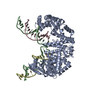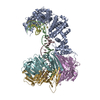[English] 日本語
 Yorodumi
Yorodumi- PDB-9eoa: Cryo_EM structure of human FAN1 in complex with 5' flap DNA subst... -
+ Open data
Open data
- Basic information
Basic information
| Entry | Database: PDB / ID: 9eoa | ||||||
|---|---|---|---|---|---|---|---|
| Title | Cryo_EM structure of human FAN1 in complex with 5' flap DNA substrate and PCNA | ||||||
 Components Components |
| ||||||
 Keywords Keywords | DNA BINDING PROTEIN / FAN1 / PCNA | ||||||
| Function / homology |  Function and homology information Function and homology informationflap-structured DNA binding / phosphodiesterase I / positive regulation of deoxyribonuclease activity / dinucleotide insertion or deletion binding / PCNA-p21 complex / mitotic telomere maintenance via semi-conservative replication / 5'-flap endonuclease activity / purine-specific mismatch base pair DNA N-glycosylase activity / nuclear lamina / positive regulation of DNA-directed DNA polymerase activity ...flap-structured DNA binding / phosphodiesterase I / positive regulation of deoxyribonuclease activity / dinucleotide insertion or deletion binding / PCNA-p21 complex / mitotic telomere maintenance via semi-conservative replication / 5'-flap endonuclease activity / purine-specific mismatch base pair DNA N-glycosylase activity / nuclear lamina / positive regulation of DNA-directed DNA polymerase activity / Polymerase switching / MutLalpha complex binding / Telomere C-strand (Lagging Strand) Synthesis / Processive synthesis on the lagging strand / PCNA complex / Removal of the Flap Intermediate / Hydrolases; Acting on ester bonds; Endodeoxyribonucleases producing 5'-phosphomonoesters / Processive synthesis on the C-strand of the telomere / Polymerase switching on the C-strand of the telomere / Mismatch repair (MMR) directed by MSH2:MSH3 (MutSbeta) / Mismatch repair (MMR) directed by MSH2:MSH6 (MutSalpha) / Transcription of E2F targets under negative control by DREAM complex / Removal of the Flap Intermediate from the C-strand / ubiquitin-modified protein reader activity / replisome / response to L-glutamate / 5'-3' exonuclease activity / phosphodiesterase I activity / response to dexamethasone / histone acetyltransferase binding / DNA polymerase processivity factor activity / G1/S-Specific Transcription / leading strand elongation / nuclear replication fork / replication fork processing / SUMOylation of DNA replication proteins / PCNA-Dependent Long Patch Base Excision Repair / response to cadmium ion / translesion synthesis / estrous cycle / interstrand cross-link repair / mismatch repair / cyclin-dependent protein kinase holoenzyme complex / intercellular bridge / base-excision repair, gap-filling / DNA polymerase binding / liver regeneration / epithelial cell differentiation / positive regulation of DNA repair / TP53 Regulates Transcription of Genes Involved in G2 Cell Cycle Arrest / Translesion synthesis by REV1 / Translesion synthesis by POLK / Translesion synthesis by POLI / positive regulation of DNA replication / Gap-filling DNA repair synthesis and ligation in GG-NER / replication fork / nuclear estrogen receptor binding / male germ cell nucleus / nucleotide-excision repair / Fanconi Anemia Pathway / Termination of translesion DNA synthesis / Recognition of DNA damage by PCNA-containing replication complex / Translesion Synthesis by POLH / double-strand break repair via homologous recombination / receptor tyrosine kinase binding / HDR through Homologous Recombination (HRR) / Dual Incision in GG-NER / cellular response to xenobiotic stimulus / cellular response to hydrogen peroxide / Dual incision in TC-NER / Gap-filling DNA repair synthesis and ligation in TC-NER / cellular response to UV / response to estradiol / E3 ubiquitin ligases ubiquitinate target proteins / heart development / chromatin organization / damaged DNA binding / chromosome, telomeric region / nuclear body / cilium / DNA repair / centrosome / chromatin binding / chromatin / protein-containing complex binding / enzyme binding / magnesium ion binding / negative regulation of transcription by RNA polymerase II / extracellular exosome / zinc ion binding / nucleoplasm / identical protein binding / nucleus / cytosol Similarity search - Function | ||||||
| Biological species |  Homo sapiens (human) Homo sapiens (human) | ||||||
| Method | ELECTRON MICROSCOPY / single particle reconstruction / cryo EM / Resolution: 3.27 Å | ||||||
 Authors Authors | Jeyasankar, G. / Salerno-Kochan, A. / Thomsen, M. | ||||||
| Funding support |  United States, 1items United States, 1items
| ||||||
 Citation Citation |  Journal: Nat Commun / Year: 2025 Journal: Nat Commun / Year: 2025Title: A FAN1 point mutation associated with accelerated Huntington's disease progression alters its PCNA-mediated assembly on DNA. Authors: Jonas Aretz / Gayathri Jeyasankar / Anna Salerno-Kochan / Maren Thomsen / Gabriel Thieulin-Pardo / Tasir Haque / Edith Monteagudo / Dan Felsenfeld / Michael Finley / Thomas F Vogt / Julien ...Authors: Jonas Aretz / Gayathri Jeyasankar / Anna Salerno-Kochan / Maren Thomsen / Gabriel Thieulin-Pardo / Tasir Haque / Edith Monteagudo / Dan Felsenfeld / Michael Finley / Thomas F Vogt / Julien Boudet / Brinda C Prasad /   Abstract: FAN1 is an endo- and exo-nuclease involved in DNA and interstrand crosslink repair. Genome-wide association studies of people with Huntington's disease revealed a strong association between the FAN1 ...FAN1 is an endo- and exo-nuclease involved in DNA and interstrand crosslink repair. Genome-wide association studies of people with Huntington's disease revealed a strong association between the FAN1 R507H mutation and early disease onset, however the underlying mechanism(s) remains unclear. FAN1 has previously been implicated in modulating triplet repeat expansion in a PCNA dependent manner. To examine the role of PCNA on FAN1 activation, we solved the cryo-EM structures of a PCNA-FAN1-DNA complex. Our findings reveal that the FAN1 R507 residue directly interacts with PCNA D232. Biophysical interaction studies demonstrated that FAN1 enhances the binding affinity of PCNA for DNA, a synergistic effect disrupted in mutants carrying the R507H mutation. In contrast, PCNA does not affect the affinity of FAN1 for DNA but does modulate FAN1 activity upon ternary complex formation. The weakened and functionally altered FAN1 R507H-PCNA-DNA complex may partly impair the FAN1-mediated repair of CAG extrahelical extrusions, providing a potential explanation for the mutation's role in accelerating disease progression. #1:  Journal: Biorxiv / Year: 2024 Journal: Biorxiv / Year: 2024Title: A FAN1 point mutation associated with accelerated Huntington's disease progression alters its PCNA-mediated assembly on DNA Authors: Aretz, J. / Jeyasankar, G. / Salerno-Kochan, A. / Thomsen, M. / Thieulin-Pardo, G. / Haque, T. / Monteagudo, E. / Felsenfeld, D. / Finley, M. / Vogt, T.F. / Boudet, J. / Prasad, B.C. | ||||||
| History |
|
- Structure visualization
Structure visualization
| Structure viewer | Molecule:  Molmil Molmil Jmol/JSmol Jmol/JSmol |
|---|
- Downloads & links
Downloads & links
- Download
Download
| PDBx/mmCIF format |  9eoa.cif.gz 9eoa.cif.gz | 307.1 KB | Display |  PDBx/mmCIF format PDBx/mmCIF format |
|---|---|---|---|---|
| PDB format |  pdb9eoa.ent.gz pdb9eoa.ent.gz | 239.9 KB | Display |  PDB format PDB format |
| PDBx/mmJSON format |  9eoa.json.gz 9eoa.json.gz | Tree view |  PDBx/mmJSON format PDBx/mmJSON format | |
| Others |  Other downloads Other downloads |
-Validation report
| Summary document |  9eoa_validation.pdf.gz 9eoa_validation.pdf.gz | 988.3 KB | Display |  wwPDB validaton report wwPDB validaton report |
|---|---|---|---|---|
| Full document |  9eoa_full_validation.pdf.gz 9eoa_full_validation.pdf.gz | 1 MB | Display | |
| Data in XML |  9eoa_validation.xml.gz 9eoa_validation.xml.gz | 51.3 KB | Display | |
| Data in CIF |  9eoa_validation.cif.gz 9eoa_validation.cif.gz | 77.2 KB | Display | |
| Arichive directory |  https://data.pdbj.org/pub/pdb/validation_reports/eo/9eoa https://data.pdbj.org/pub/pdb/validation_reports/eo/9eoa ftp://data.pdbj.org/pub/pdb/validation_reports/eo/9eoa ftp://data.pdbj.org/pub/pdb/validation_reports/eo/9eoa | HTTPS FTP |
-Related structure data
| Related structure data |  19850MC  8s5aC  9eo1C  9gy0C M: map data used to model this data C: citing same article ( |
|---|---|
| Similar structure data | Similarity search - Function & homology  F&H Search F&H Search |
- Links
Links
- Assembly
Assembly
| Deposited unit | 
|
|---|---|
| 1 |
|
- Components
Components
| #1: Protein | Mass: 72629.703 Da / Num. of mol.: 1 Source method: isolated from a genetically manipulated source Source: (gene. exp.)  Homo sapiens (human) / Gene: FAN1, KIAA1018, MTMR15 / Production host: Homo sapiens (human) / Gene: FAN1, KIAA1018, MTMR15 / Production host:  References: UniProt: Q9Y2M0, Hydrolases; Acting on ester bonds; Endodeoxyribonucleases producing 5'-phosphomonoesters, phosphodiesterase I | ||
|---|---|---|---|
| #2: DNA chain | Mass: 12154.740 Da / Num. of mol.: 1 / Source method: obtained synthetically / Source: (synth.)  Homo sapiens (human) Homo sapiens (human) | ||
| #3: DNA chain | Mass: 8618.535 Da / Num. of mol.: 1 / Source method: obtained synthetically / Source: (synth.)  Homo sapiens (human) Homo sapiens (human) | ||
| #4: DNA chain | Mass: 6554.223 Da / Num. of mol.: 1 / Source method: obtained synthetically / Source: (synth.)  Homo sapiens (human) Homo sapiens (human) | ||
| #5: Protein | Mass: 28278.309 Da / Num. of mol.: 3 Source method: isolated from a genetically manipulated source Source: (gene. exp.)  Homo sapiens (human) / Gene: PCNA / Production host: Homo sapiens (human) / Gene: PCNA / Production host:  Has protein modification | Y | |
-Experimental details
-Experiment
| Experiment | Method: ELECTRON MICROSCOPY |
|---|---|
| EM experiment | Aggregation state: PARTICLE / 3D reconstruction method: single particle reconstruction |
- Sample preparation
Sample preparation
| Component |
| ||||||||||||||||||||||||
|---|---|---|---|---|---|---|---|---|---|---|---|---|---|---|---|---|---|---|---|---|---|---|---|---|---|
| Source (natural) |
| ||||||||||||||||||||||||
| Source (recombinant) |
| ||||||||||||||||||||||||
| Buffer solution | pH: 7.5 | ||||||||||||||||||||||||
| Specimen | Embedding applied: NO / Shadowing applied: NO / Staining applied: NO / Vitrification applied: YES | ||||||||||||||||||||||||
| Vitrification | Cryogen name: ETHANE-PROPANE |
- Electron microscopy imaging
Electron microscopy imaging
| Microscopy | Model: TFS GLACIOS |
|---|---|
| Electron gun | Electron source:  FIELD EMISSION GUN / Accelerating voltage: 200 kV / Illumination mode: OTHER FIELD EMISSION GUN / Accelerating voltage: 200 kV / Illumination mode: OTHER |
| Electron lens | Mode: OTHER / Nominal defocus max: 2200 nm / Nominal defocus min: 800 nm |
| Image recording | Electron dose: 50 e/Å2 / Film or detector model: FEI FALCON IV (4k x 4k) |
- Processing
Processing
| CTF correction | Type: PHASE FLIPPING AND AMPLITUDE CORRECTION | ||||||||||||||||||||||||
|---|---|---|---|---|---|---|---|---|---|---|---|---|---|---|---|---|---|---|---|---|---|---|---|---|---|
| 3D reconstruction | Resolution: 3.27 Å / Resolution method: FSC 0.143 CUT-OFF / Num. of particles: 700432 / Symmetry type: POINT | ||||||||||||||||||||||||
| Refine LS restraints |
|
 Movie
Movie Controller
Controller





 PDBj
PDBj













































